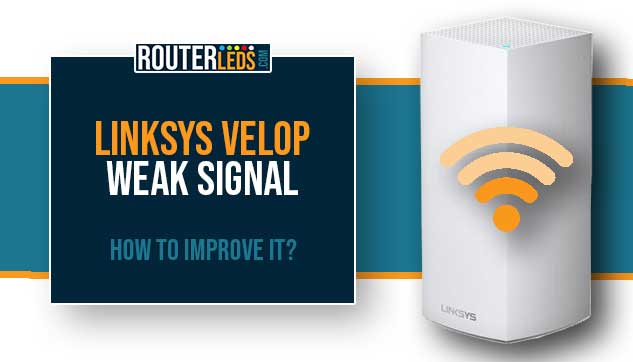If you are experiencing Linksys Velop weak signal issues, the first thing to do would be to understand what is causing it. This problem can be pretty inconvenient since it results in slow internet speeds, spotty connections, and frequent disconnections.
Understanding the issue will point you in the right direction of improving your Linksys Velop signal and your browsing experience as well. Also if the signal is weak you may notice the orange light on your Linksys Velop.
What Causes A Weak Signal On Linksys Velop?
Here are the most frequent causes of the Linksys Velop weak signal issue.
Physical Barriers
The main cause of the weak signal is physical obstructions such as walls, floors, and furniture. These elements can severely affect your Wi-Fi signal strength and coverage.
Distance
Wi-Fi signals become weaker as they travel over a distance. Logically, the signal strength will be weaker as you move your device away from the Velop node.
Interference From Other Devices
Electrical appliances and other Wi-Fi networks can interfere with your Linksys Velop signal. Devices like microwave ovens, cordless phones, Bluetooth speakers, and other routers operating on the same frequency can weaken your Linksys Velop signal.
Overloaded Network
If too many devices are connected to the same node, the network may become overloaded. This decreases the network performance and affects the signal strength.
How To Improve The Linksys Velop Weak Signal
Now that we know what might be causing the issue, we can start exploring the solutions. There are a few solutions you can try in order to improve your Linksys Velop weak signal.
Position The Nodes Correctly
Placing your Velop nodes carefully is pretty important when it comes to improving the strength of your Wi-Fi signal. Make sure the node is placed in a more open area. Here are a few placement tips for optimal performance.
Centralize Your Primary Node – The primary node is the one connected directly to the modem. Ideally, you should place it in the central part of your home or office. This will ensure that the wireless signal is broadcasted in all directions, covering a large area of your home.
Place Additional Nodes Strategically – Having additional nodes to cover all the areas of your home is a great idea. However, you need to make sure they are within range of the primary node. This will help them pick up the Wi-Fi signal more effectively.
Avoid Physical Obstacles – Avoid placing your nodes near thick walls or in enclosed spaces. Physical obstacles can weaken the Linksys Velop Wi-Fi signal. Place your nodes in open, high places where possible.
Minimize Interference
Interference from other devices is a common issue that can greatly reduce your Wi-Fi signal. Here is how to minimize this problem.
Keep Nodes Away From Other Wireless Devices – Wireless devices such as baby monitors, cordless phones, microwaves, and Bluetooth speakers can interfere with your Wi-Fi signal. If possible, keep your nodes away from these devices or move the devices away from the node.
Use Different Channels – Wi-Fi signals from your neighbors can interfere with your Wi-Fi signal if they are on the same channel. You can manually change the channel on your Linksys Velop to avoid this.
Manage Your Network Load
If you have too many devices connected to a single node, it will become overloaded. As a result, your Wi-Fi signal will be weak. Here is how to reduce network load.
Distribute Devices Evenly – If possible, make sure to distribute your devices evenly across the nodes. Overloading one node can make it perform poorly. Of course, this doesn’t apply to mobile devices like tablets, smartphones, or laptops as they will connect to the closest node. Read what to do when devices won’t connect to the closest node.
Prioritize Your Devices – The Linksys Velop allows you to prioritize up to three devices, making sure they get the best possible Wi-Fi signal. If some of your devices need more bandwidth than other devices, use this feature.
Update Your Linksys Velop Firmware
Having the latest firmware version installed on your Linksys Velop can improve your signal strength.
Therefore, check for firmware updates from time to time, although your Velop system should take care of it automatically. These updates often come with bug fixes and performance enhancements.
Perform A Factory Reset
If you’ve tried everything and your signal is still weak, a factory reset can be your last chance. This action will reset your Linksys Velop system to its original settings and might help resolve persistent weak signal issues. It is recommended to back up your settings before performing a factory reset.
Frequently Asked Questions
Not necessarily. A weak signal doesn’t always mean your Linksys Velop device is defective. It could be due to poor placement of your nodes, interference from other devices, or an outdated firmware version. Before concluding that your device is defective, try to optimize your nodes placement and update your device to the latest firmware.
Yes, the number of nodes can significantly impact the signal strength of your Linksys Velop system. Additional nodes can help extend the Wi-Fi coverage to areas that were previously experiencing weak signals. However, it is important to position these nodes carefully.
There are several possible reasons for the Linksys Velop weak signal. These could include physical obstructions such as walls or furniture, interference from other wireless devices, or the distance between your devices and the Velop node. Making sure your nodes are placed in optimal locations can significantly improve your signal strength.
Conclusion
If you follow and apply the steps given above, improving your Linksys Velop signal strength should be a straightforward task.
Remember, sometimes, the simplest solution like repositioning your nodes can make all the difference. So, go ahead and try out these steps, and enjoy a stronger, more reliable Wi-Fi connection!

